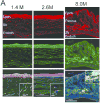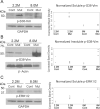Sustained activation of ERK1/2 MAPK in Schwann cells causes corneal neurofibroma
- PMID: 28489286
- PMCID: PMC5586542
- DOI: 10.1002/jnr.24067
Sustained activation of ERK1/2 MAPK in Schwann cells causes corneal neurofibroma
Abstract
Recent studies have shown that constitutive activation of extracellular signal-regulated kinases 1 and 2 (ERK1/2) in Schwann cells (SCs) increases myelin thickness in transgenic mice. In this secondary analysis, we report that these transgenic mice develop a postnatal corneal neurofibroma with the loss of corneal transparency by age six months. We show that expansion of non-myelinating SCs, under the control of activated ERK1/2, also drive myofibroblast differentiation that derives from both SC precursors and resident corneal keratocytes. Further, these mice also harbor activated mast cells in the central cornea, which contributes to pathological corneal neovascularization and fibrosis. This breach of corneal avascularity and immune status is associated with the growth of the tumor pannus, resulting in a corneal stroma that is nearly four times its normal size. In corneas with advanced disease, some axons became ectopically myelinated, and the disruption of Remak bundles is evident. To determine whether myofibroblast differentiation was linked to vimentin, we examined the levels and phosphorylation status of this fibrotic biomarker. Concomitant with the early upregulation of vimentin, a serine 38-phosphorylated isoform of vimentin (pSer38vim) increased in SCs, which was attributed primarily to the soluble fraction of protein-not the cytoskeletal portion. However, the overexpressed pSer38vim became predominantly cytoskeletal with the growth of the corneal tumor. Our findings demonstrate an unrecognized function of ERK1/2 in the maintenance of corneal homeostasis, wherein its over-activation in SCs promotes corneal neurofibromas. This study is also the first report of a genetically engineered mouse that spontaneously develops a corneal tumor.
Keywords: AB_10013383; AB_141637; AB_2107448; AB_2216097; AB_2223021; AB_2257290; AB_2315112; AB_306067; AB_444319; AB_476744; AB_628437; ERK; Schwann cells; corneal fibrosis; neurofibroma; soluble vimentin.
© 2017 Wiley Periodicals, Inc.
Conflict of interest statement
The authors have no conflicts of interest.
Figures















Similar articles
-
Corneal nonmyelinating Schwann cells illuminated by single-cell transcriptomics and visualized by protein biomarkers.J Neurosci Res. 2021 Mar;99(3):731-749. doi: 10.1002/jnr.24757. Epub 2020 Nov 16. J Neurosci Res. 2021. PMID: 33197966 Free PMC article.
-
Vimentin Phosphorylation Underlies Myofibroblast Sensitivity to Withaferin A In Vitro and during Corneal Fibrosis.PLoS One. 2015 Jul 17;10(7):e0133399. doi: 10.1371/journal.pone.0133399. eCollection 2015. PLoS One. 2015. PMID: 26186445 Free PMC article.
-
Vimentin phosphorylation by Cdc2 in Schwann cell controls axon growth via β1-integrin activation.FASEB J. 2012 Jun;26(6):2401-13. doi: 10.1096/fj.11-199018. Epub 2012 Feb 27. FASEB J. 2012. PMID: 22371530
-
Cross-talk between growth factor and purinergic signalling regulates Schwann cell proliferation.Novartis Found Symp. 2006;276:162-75; discussion 175-80, 233-7, 275-81. Novartis Found Symp. 2006. PMID: 16805429 Review.
-
It takes two to tango: mast cell and Schwann cell interactions in neurofibromas.J Clin Invest. 2003 Dec;112(12):1791-3. doi: 10.1172/JCI20503. J Clin Invest. 2003. PMID: 14679174 Free PMC article. Review.
Cited by
-
The Physicochemical Properties of Decellularized Extracellular Matrix-Coated 3D Printed Poly(ε-caprolactone) Nerve Conduits for Promoting Schwann Cells Proliferation and Differentiation.Materials (Basel). 2018 Sep 9;11(9):1665. doi: 10.3390/ma11091665. Materials (Basel). 2018. PMID: 30205596 Free PMC article.
-
Corneal nonmyelinating Schwann cells illuminated by single-cell transcriptomics and visualized by protein biomarkers.J Neurosci Res. 2021 Mar;99(3):731-749. doi: 10.1002/jnr.24757. Epub 2020 Nov 16. J Neurosci Res. 2021. PMID: 33197966 Free PMC article.
-
Neuregulin 1 type III improves peripheral nerve myelination in a mouse model of congenital hypomyelinating neuropathy.Hum Mol Genet. 2019 Apr 15;28(8):1260-1273. doi: 10.1093/hmg/ddy420. Hum Mol Genet. 2019. PMID: 30535360 Free PMC article.
-
Eye of the beholder: Rare eye diseases in focus.J Neurosci Res. 2019 Jan;97(1):3-6. doi: 10.1002/jnr.24348. J Neurosci Res. 2019. PMID: 30444055 Free PMC article. Review. No abstract available.
-
Mesenchymal Stem Cell Exosomes as Immunomodulatory Therapy for Corneal Scarring.Int J Mol Sci. 2023 Apr 18;24(8):7456. doi: 10.3390/ijms24087456. Int J Mol Sci. 2023. PMID: 37108619 Free PMC article.
References
-
- Ambati BK, Nozaki M, Singh N, Takeda A, Jani PD, Suthar T, Albuquerque RJ, Richter E, Sakurai E, Newcomb MT, Kleinman ME, Caldwell RB, Lin Q, Ogura Y, Orecchia A, Samuelson DA, Agnew DW, St Leger J, Green WR, Mahasreshti PJ, Curiel DT, Kwan D, Marsh H, Ikeda S, Leiper LJ, Collinson JM, Bogdanovich S, Khurana TS, Shibuya M, Baldwin ME, Ferrara N, Gerber HP, De Falco S, Witta J, Baffi JZ, Raisler BJ, Ambati J. Corneal avascularity is due to soluble VEGF receptor-1. Nature. 2006;443(7114):993–997. - PMC - PubMed
-
- Belmonte C, Acosta MC, Gallar J. Neural basis of sensation in intact and injured corneas. Exp Eye Res. 2004;78(3):513–525. - PubMed
Publication types
MeSH terms
Substances
Grants and funding
LinkOut - more resources
Full Text Sources
Other Literature Sources
Medical
Miscellaneous

